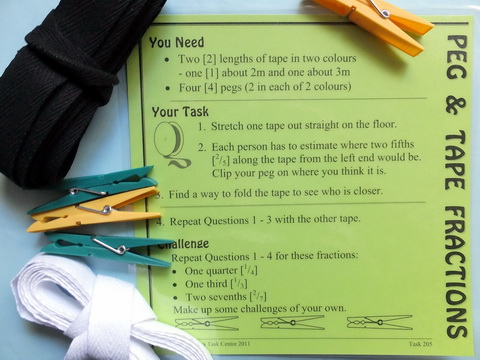
Fraction Estimation
|
Materials
Content
|

IcebergA task is the tip of a learning iceberg. There is always more to a task than is recorded on the card. |
Whether it's teachers in workshops...
 
Or kids in classrooms...
  (Nichola Brandon's Year 4 at St. Benedict's, Narrabundah) this task seems to hook everyone in. St. Thomas More's SchoolThere are at least three ways ways of folding to check for the closest peg to the required fraction. The students are being challenged to estimate, so they can't be wrong. Their estimates can only be more or less close to the target, which in the examples here is two fifths. A ruler is not required.
It is expected that students will try estimating several different fractions using the two whole lengths provided. ExtensionProvide two tapes the same length to be wholes. Place a peg half way along one whole first, then estimate and clip mini-pegs to show tenths. This will be a reference whole, so the accuracy of the estimate can be checked by measurement to confirm the pegs are as correctly placed as possible.(Alternatively use a metre ruler as one whole and accurately mark tenths on the blank side guided by the decimetres on the measurement side. Provide another tape that is exactly one metre.) Without reference to the tenths tape, the second whole is pegged in (say) thirds, as in Fraction Estimation (Peg & Tape Fractions). The two wholes are now laid side by side to explore how thirds (or any other fraction) relate to tenths.
|
Whole Class InvestigationTasks are an invitation for two students to work like a mathematician. Tasks can also be modified to become whole class investigations which model how a mathematician works. |
With a few lengths of herring bone tape and a couple of packets of pegs (or mini-pegs) a school can easily produce a class set of material to turn this task into a whole class investigation. Use one tape first with the whole class and ask three volunteers to each place their colour of peg where they estimate 2/5 will be. Allow them to stand back and take a second look, altering their estimate if necessary. Briefly discuss strategies used to estimate. Ask the class how these hypotheses could be checked and carry out any suggestions. (It is actually rare that anyone suggests measuring.) Repeat the activity with another fraction and another set of three students, then separate the class into groups of 4 - 6 and hand out pegs and tape to each group. The tapes need not be the same length. Ask all groups to try the same task, say 3/7, and discuss how it is achieved and checked. Take a few minutes for students to record in words and pictures, then encourage groups to try their own fractions.
|
Is it in Maths With Attitude?Maths With Attitude is a set of hands-on learning kits available from Years 3-10 which structure the use of tasks and whole class investigations into a week by week planner. |
The Fraction Estimation task is an integral part of:
The Fraction Estimation lesson which is based on this task is an integral part of:
|